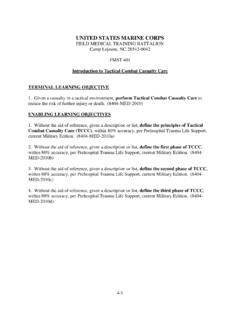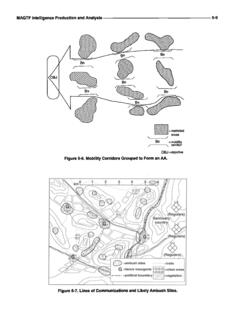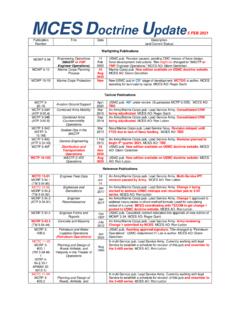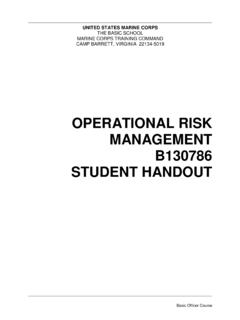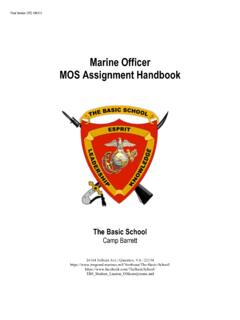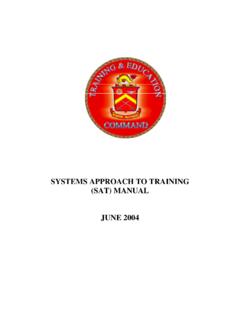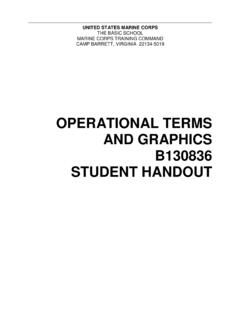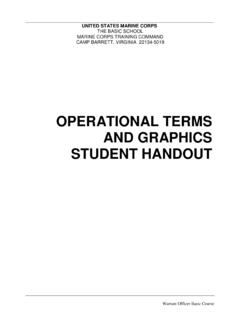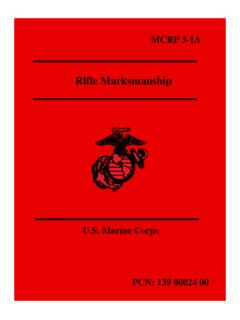Transcription of Tactical Employment of Mortars - United States Marine Corps
1 MCWP FM 7-90 Tactical Employment of Mortars Marine Corps PCN 143 000092 00 *FM 7-90 Field Manual NO. 7-90 HEADQUARTERS DEPARTMENT OF THE ARMY Washington, DC, 9 October 1992 FM 7-90 MCWP Tactical Employment OF Mortars Table of Contents PREFACE CHAPTER 1 - MORTAR SECTIONS AND PLATOONS ON THE AIRLAND BATTLEFIELD 1-1. Role of Mortars 1-2. Tenets of Airland Battle 1-3. Company- and Battalion-Level Battle 1-4. Mortar Characteristics and Organizations 1-5. Associated Organizations CHAPTER 2 - COMMAND AND CONTROL OF MORTAR SECTIONS AND PLATOONS 2-1. Responsibilities of Key Personnel 2-2. Troop-Leading Procedures 2-3. Combat Orders and Overlays CHAPTER 3 - FIRE SUPPORT PLANNING AND COORDINATION Section I - Mortar Support and Command Relationships 3-1. Command Relationships 3-2.
2 Support Relationships Section II - Fire Support Planning 3-3. Purpose of Indirect Fires 3-4. Effects of Indirect Fires 3-5. Fire Support Coordination Measures, Terms, and Techniques 3-6. Target Data Processing 3-7. Battalion Fire Support Plan 3-8. Battalion Target List and Overlay 3-9. Processing and Coordinating Calls For Mortar Fire 3-10. Ammunition Supply Rates CHAPTER 4 - Mortars IN SUPPORT OF OFFENSIVE OPERATIONS 4-1. Historical Example 4-2. Mortar Support During Offensive Operations 4-3. Types of Offensive Operations 4-4. Other Offensive Operations 4-5. Mortar Offensive Fire Support 4-6. Other Operations CHAPTER 5 - Mortars IN SUPPORT OF DEFENSIVE AND RETROGRADE OPERATIONS 5-1. Defensive Operations 5-2. Priority of Fires and Priority Targets 5-3. Mortar Defensive Fire Suport Tasks 5-4. Retrograde Operations 5-5. Mortar Units Supporting Retrograde Operations CHAPTER 6 - MORTAR PLATOON AND SECTION TACTICS, TECHNIQUES, AND PROCEDURES Section I - Employment Techniques 6-1.
3 Employment by Platoon 6-2. Employment by Section 6-3. Employment by Squad Section II - Reconnaissance, Selection, and Occupation of Mortar Positions 6-4. Definition 6-5. Methods of Reconnaissance 6-6. Planning the Reconnaissance 6-7. Reconnaissance Party 6-8. Position Selection 6-9. Advance Party Operations 6-10. Occupation 6-11. Movement Briefing 6-12. Night Occupations 6-13. Types of Occupation 6-14. Deliberate Occupation 6-15. Hasty Occupation 6-16. Sustainment Section III - Displacement Planning 6-17. Displacement Timing 6-18. Displacement Plans During Offense, Defense, and Retrograde Operations Section IV - Displacement Techniques 6-19. Displacement by Platoon 6-20. Displacement by Sections 6-21. Displacement by Squad(s) or Section(-) Section V - Movement 6-22. Independent Movement 6-23. Open Column 6-24. Closed Column 6-25. Infiltration 6-26. Terrain March 6-27.
4 Movement Orders 6-28. Load Plans 6-29. Movement Preparation 6-30. Organization of the Platoon Column 6-31. March Discipline 6-32. Convoy Control Measures 6-33. Halts 6-34. March Column Contingencies Section VI - Mortar Section and Platoon Firing Formations 6-35. Terrain Mortar Positioning 6-36. Parallel formation 6-37. Lazy W formation 6-38. Diamond formation 6-39. Triangle formation 6-40. Six-Mortar star formation CHAPTER 7 - SURVIVABILITY TECHNIQUES AND DEFENSE OF A MORTAR FIRING POSITION Section I - Threats to Mortar Survivability 7-1. Threats 7-2. Ground attack 7-3. Air Attack 7-4. Survivability Techniques Section II - Dug-In Positions 7-5. Dismounted Mortars 7-6. FDC Bunkers 7-7. Mounted Mortars 7-8. Mortar Positions in a Strongpoint 7-9. High-Survivability Mortar Position 7-10. Additional Individual Protection Section III - Other Survivability Techniques 7-11.
5 Shoot and Hide Positions 7-12. Camouflage 7-13. Firing Lowest Charge and Elevation 7-14. Frequent Displacement 7-15. Offset Registration 7-16. Roving Gun 7-17. Adjusting Rounds 7-18. Use of Wire Communications 7-19. Massing Fires 7-20. Terrain Mortar Positioning 7-21. Ground Defense Plan 7-22. Coordination and Security Plan 7-23. Defense Plan 7-24. Conduct of the Defense CHAPTER 8 - SPECIAL CONSIDERATIONS FOR THE 60-mm MORTAR SECTION 8-1. Light Mortars on the Battlefield 8-2. Organizations 8-3. Responsibilities 8-4. Employment Options 8-5. Displacement 8-6. Reconnaissance and Position Selection 8-7. Types of Engagement 8-8. Support and Command Relationships 8-9. Support During Offensive Operations 8-10. Support During a Movement to Contact 8-11. Support During a Hasty Attack 8-12. Support During a Deliberate Attack 8-13. Support During Defensive Operations 8-14.
6 Rates of Fire 8-15. Load-Carrying Techniques 8-16. Load-Carrying Devices CHAPTER 9 - COMBAT SERVICE SUPPORT Section I - Trains 9-1. Field Trains 9-2. Combat Trains 9-3. Company Trains 9-4. Request for Support and Routine Supplies Section II - Resupply 9-5. Resupply Operations 9-6. Resupply Techniques 9-7. In-Position Resupply 9-8. Prepositioning 9-9. Out of Position 9-10. Emergency Resupply 9-11. Basic Loads 9-12. Common Supplies 9-13. Miscellaneous Supplies Section III - Maintenance 9-14. Vehicles 9-15. Weapons 9-16. Communications Equipment 9-17. Mortar Equipment 9-18. Recovery of Damaged Equipment Section IV - Mortar Medical Support 9-19. Company Mortars 9-20. Battalion Mortars 9-21. Evacuation 9-22. Casualty and Strength Reporting APPENDIX A - ORDERS, FORMATS, AND SUPPLEMENTS APPENDIX B - TARGET EFFECTS PLANNING APPENDIX C - MORTAR SMOKE OPERATIONS APPENDIX D - CRATER ANALYSIS APPENDIX E - OPERATIONS SECURITY APPENDIX F - FIRE WITHOUT AN FDC AND EMERGENCY ENGAGEMENT TECHNIQUES APPENDIX G - SUSTAINED AND CONTINUOUS OPERATIONS APPENDIX H - REPORTS APPENDIX I - HELICOPTER OPERATIONS APPENDIX J - MORTAR OPERATIONS ON URBANIZED TERRAIN APPENDIX K - MORTAR ORGANIZATIONS APPENDIX L - MORTAR AND ARTILLERY RADIO AND WIRE NETS APPENDIX M - MORTAR PLATOON STANDING OPERATING PROCEDURES GLOSSARY REFERENCES BLANK FORMS AUTHORIZATION LETTER DISTRIBUTION RESTRICTION: Approved for public release; distribution is unlimited.
7 *This publication supersedes FM 7-90, 11 June 1985. CHAPTER 1 MORTAR SECTIONS AND PLATOONS ON THE AIRLAND BATTLEFIELD All maneuver units require indirect fire to win. Mortar sections and platoons provide unique indirect fires that are organizationally responsive to the ground maneuver commander. Military history has repeatedly demonstrated the effectiveness of Mortars . Their rapid, high-angle, plunging fires are invaluable against dug-in enemy troops and targets in defilade, which are not vulnerable to attack by direct fires. Although they are part of the total fire support system, mortar sections and platoons are not simply small artillery batteries. They play a unique and vital role on the AirLand Battlefield. By virtue of their organization at both company and battalion levels, they provide valuable and responsive fires that ease the combat tasks of company, battalion, and brigade commanders.
8 1-1. ROLE OF Mortars The primary role of Mortars is to provide immediately available, responsive indirect fires that support the maneuver of the company or battalion, and that reinforce direct fires during close combat. In the attack, effective maneuver requires a base of fire, both direct and indirect, to do the following: To establish the conditions for maneuver. To suppress the enemy. To fix him in place. To provide close supporting fires for the assault. In the defense, this base of fire is used as follows: To force armored vehicles to button up. To breakup enemy troop concentrations. To reduce the enemy's mobility and canalize his assault forces into engagement areas. To deny him the advantage of defilade terrain and force him into areas covered by direct fire weapons. To break up the enemy combined arms team and destroy his synchronization.
9 To protect the infantry against a close dismounted assault. a. Mortar sections and platoons provide the commander with-- (1) An organic indirect fire capability that is always present and always responsive to the maneuver commander regardless of the changing demands placed on any supporting field artillery. (2) Supporting fire that is immediately at hand and close to the company and battalion fight. The mortar section or platoon is aware of the local situation and ready to respond quickly without lengthy coordination. (3) Unique plunging fires that complement, but do not replace, the heavier fires of supporting field artillery, close air support, and naval gunfire. (4) Weapons whose high rate of fire and lethality fill the gap between the time field artillery fires shift to deeper targets, and the assault elements close onto the objective. (5) A solid base of fire upon which to anchor his maneuver to the critical point of enemy weakness.
10 B. Mortars allow the maneuver commander to quickly place killing indirect fires on the enemy, independent of whether he has been allocated supporting artillery. Heavy forces use carrier-mounted Mortars to allow the mortar platoon to move cross-country at speeds compatible with the battalion task force. Light forces use wheeled vehicles or hand carry Mortars into firing positions. Some companies have light Mortars that can be manpacked across all terrain. All mortar sections and platoons exist to provide immediate, organizationally responsive fires that can be used to meet the rapid changes in the Tactical situation on the AirLand Battlefield. c. The three primary types of mortar fires are as follows: (1) High explosive. High-explosive rounds are used to suppress or kill enemy dismounted infantry, Mortars , and other supporting weapons, and to interdict the movement of men, vehicles and supplies in the enemy's forward area.
